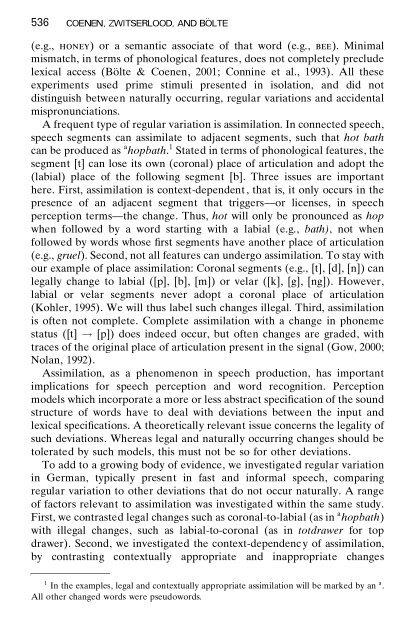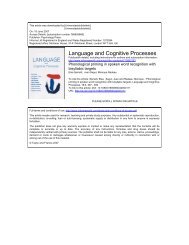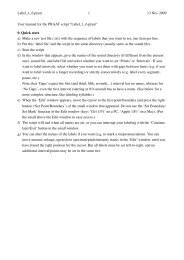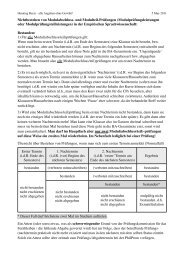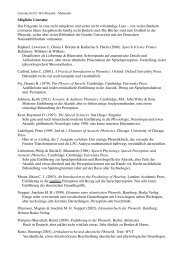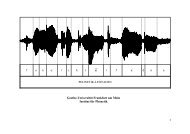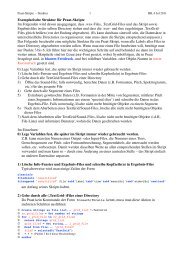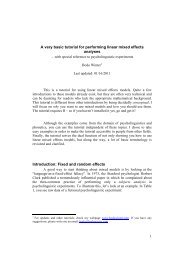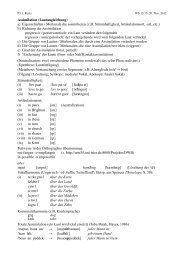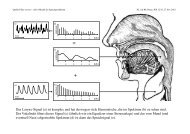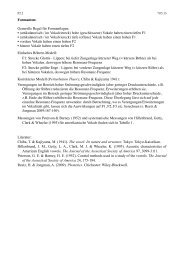Variation and assimilation in German - Institut für Phonetik
Variation and assimilation in German - Institut für Phonetik
Variation and assimilation in German - Institut für Phonetik
You also want an ePaper? Increase the reach of your titles
YUMPU automatically turns print PDFs into web optimized ePapers that Google loves.
536 COENEN, ZWITSERLOOD, AND BOÈLTE<br />
(e.g., honey) or a semantic associate of that word (e.g., bee). M<strong>in</strong>imal<br />
mismatch, <strong>in</strong> terms of phonological features, does not completely preclude<br />
lexical access (Bölte & Coenen, 2001; Conn<strong>in</strong>e et al., 1993). All these<br />
experiments used prime stimuli presented <strong>in</strong> isolation, <strong>and</strong> did not<br />
dist<strong>in</strong>guish between naturally occurr<strong>in</strong>g, regular variations <strong>and</strong> accidental<br />
mispronunciations.<br />
A frequent type of regular variation is <strong>assimilation</strong>. In connected speech,<br />
speech segments can assimilate to adjacent segments, such that hot bath<br />
can be produced as a hopbath. 1 Stated <strong>in</strong> terms of phonological features, the<br />
segment [t] can lose its own (coronal) place of articulation <strong>and</strong> adopt the<br />
(labial) place of the follow<strong>in</strong>g segment [b]. Three issues are important<br />
here. First, <strong>assimilation</strong> is context-dependent , that is, it only occurs <strong>in</strong> the<br />
presence of an adjacent segment that triggers—or licenses, <strong>in</strong> speech<br />
perception terms—the change. Thus, hot will only be pronounced as hop<br />
when followed by a word start<strong>in</strong>g with a labial (e.g., bath), not when<br />
followed by words whose rst segments have another place of articulation<br />
(e.g., gruel). Second, not all features can undergo <strong>assimilation</strong>. To stay with<br />
our example of place <strong>assimilation</strong>: Coronal segments (e.g., [t], [d], [n]) can<br />
legally change to labial ([p], [b], [m]) or velar ([k], [g], [ng]). However,<br />
labial or velar segments never adopt a coronal place of articulation<br />
(Kohler, 1995). We will thus label such changes illegal. Third, <strong>assimilation</strong><br />
is often not complete. Complete <strong>assimilation</strong> with a change <strong>in</strong> phoneme<br />
status ([t] ! [p]) does <strong>in</strong>deed occur, but often changes are graded, with<br />
traces of the orig<strong>in</strong>al place of articulation present <strong>in</strong> the signal (Gow, 2000;<br />
Nolan, 1992).<br />
Assimilation, as a phenomenon <strong>in</strong> speech production, has important<br />
implications for speech perception <strong>and</strong> word recognition. Perception<br />
models which <strong>in</strong>corporate a more or less abstract specication of the sound<br />
structure of words have to deal with deviations between the <strong>in</strong>put <strong>and</strong><br />
lexical specications. A theoretically relevant issue concerns the legality of<br />
such deviations. Whereas legal <strong>and</strong> naturally occurr<strong>in</strong>g changes should be<br />
tolerated by such models, this must not be so for other deviations.<br />
To add to a grow<strong>in</strong>g body of evidence, we <strong>in</strong>vestigated regular variation<br />
<strong>in</strong> <strong>German</strong>, typically present <strong>in</strong> fast <strong>and</strong> <strong>in</strong>formal speech, compar<strong>in</strong>g<br />
regular variation to other deviations that do not occur naturally. A range<br />
of factors relevant to <strong>assimilation</strong> was <strong>in</strong>vestigated with<strong>in</strong> the same study.<br />
First, we contrasted legal changes such as coronal-to-labial (as <strong>in</strong> a hopbath)<br />
with illegal changes, such as labial-to-coronal (as <strong>in</strong> totdrawer for top<br />
drawer). Second, we <strong>in</strong>vestigated the context-dependenc y of <strong>assimilation</strong>,<br />
by contrast<strong>in</strong>g contextually appropriate <strong>and</strong> <strong>in</strong>appropriate changes<br />
1 In the examples, legal <strong>and</strong> contextually appropriate <strong>assimilation</strong> will be marked by an a .<br />
All other changed words were pseudowords.


